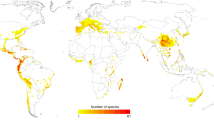Abstract
This article compares amphibian and reptile components of the original and revised versions of the Red List of Japan, and analyzes geographic patterns of, and major threats to, species and subspecies now assigned to the threatened categories. The numbers of both amphibians and reptiles categorized as threatened in the Red List of Japan have increased greatly through its revision as a result of recent progress in the taxonomy of these groups in Japan, the introduction of new criteria for risk assessment, and unexpectedly rapid declines in the status of several taxa. Threatened taxa of amphibians and reptiles in the revised list tend to be concentrated in the Ryukyu Archipelago, where deforestation seems to be the major ultimate cause of declines. Reduction in the quality and quantity of inland water environments seems to be the major cause of declines in several endemic amphibians from the main islands of Japan. The importance of conservation was emphasized in the revised list by progress in taxonomy, by new insights and data on the estimation of temporal dynamics of population density or habitat size for threatened taxa, and by the impacts of and need to prevent further deforestation in the Ryukyus and of the ongoing destruction of inland water habitats on the main islands of Japan.
Similar content being viewed by others
Author information
Authors and Affiliations
Additional information
Received: May 6, 1999 / Accepted: October 26, 1999
Rights and permissions
About this article
Cite this article
Ota, H. Current status of the threatened amphibians and reptiles of Japan. Popul Ecol 42, 5–9 (2000). https://doi.org/10.1007/s101440050003
Issue Date:
DOI: https://doi.org/10.1007/s101440050003




